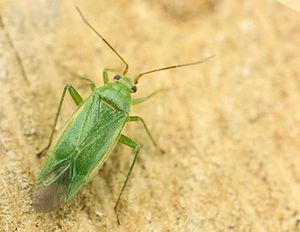Lygocoris pabulinus
| Lygocoris pabulinus | ||||||||||||
|---|---|---|---|---|---|---|---|---|---|---|---|---|

Lygocoris pabulinus |
||||||||||||
| Systematics | ||||||||||||
|
||||||||||||
| Scientific name | ||||||||||||
| Lygocoris pabulinus | ||||||||||||
| ( Linnaeus , 1761) |
Lygocoris pabulinus is a type of bug from the family of soft bugs (Miridae).
features
The bugs are 5.0 to 6.7 millimeters long. The species of the genus Lygocoris can be distinguished from other, similar green colored soft bugs by their very fine and inconspicuous pale brown spurs on the rails ( tibia ) and the gap in the keel between the compound eyes , which can be seen under high magnification. Lygocoris pabulinus has a smooth pronotum and the entire upper side of the body is colored uniformly green. Lygocoris rugicollis and Apolygus species are similar.
Occurrence and habitat
The species is distributed holarctic and occurs all over Europe including the western Mediterranean region. The species is widespread and common in Central Europe. It prefers shady habitats.
Way of life
The bugs live on deciduous trees, especially on rose plants (Rosaceae) such as apples ( Malus ), Prunus species and hawthorns ( Crataegus ) and also on representatives of other families. In damp places they can be found on herbaceous plants such as nettles ( Urtica ), mints ( Mentha ), meadowsweet ( Filipendula ), bulls ( Atriplex ), nightshade ( Solanum ) or dock ( Rumex ). In agriculture, the bugs can be harmful to apples, potatoes, sugar beet or also to ornamental plants, as they disturb the development of fruits and shoots by sucking them. They also suck nectar from umbellifers (Apiaceae) and daisy family (Asteraceae).
The species forms two generations per year in Central Europe, only one in the Alps and the higher altitudes of the low mountain ranges. The overwintering takes place in the form of eggs, which are first laid by the females on a woody host plant. The adults of the new generation appear from May / June. In summer they switch to an herbaceous host plant, where they lay their eggs in June and July. From these the second generation develops, whose adults appear from August and lay their eggs in September and October on the young shoots of woody host plants for wintering.
supporting documents
Individual evidence
- ↑ a b c d Ekkehard Wachmann , Albert Melber, Jürgen Deckert: Bugs. Volume 2: Cimicomorpha: Microphysidae (lichen bugs), Miridae (soft bugs) (= The animal world of Germany and the adjacent parts of the sea according to their characteristics and their way of life . 75th part). Goecke & Evers, Keltern 2006, ISBN 3-931374-57-2 , p. 83 f .
- ↑ Lygocoris pabulinus. British Bugs, accessed January 3, 2015 .
literature
- Ekkehard Wachmann , Albert Melber, Jürgen Deckert: Bugs. Volume 2: Cimicomorpha: Microphysidae (lichen bugs), Miridae (soft bugs) (= The animal world of Germany and the adjacent parts of the sea according to their characteristics and their way of life . 75th part). Goecke & Evers, Keltern 2006, ISBN 3-931374-57-2 .
Web links
- Lygocoris pabulinus in Fauna Europaea. Retrieved January 3, 2015
